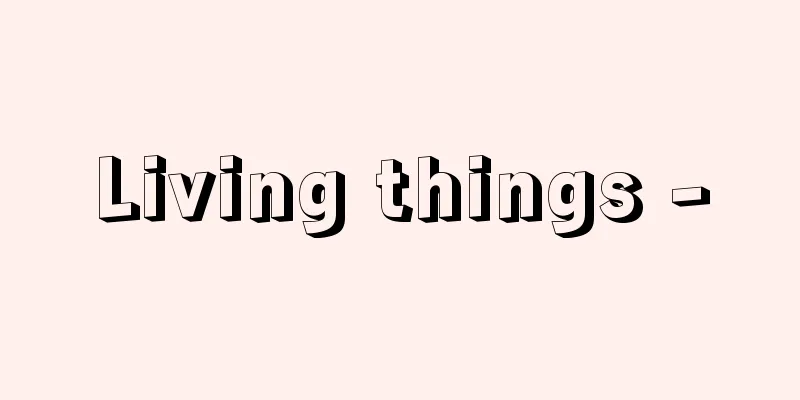Living things -

|
It refers to something that has attributes that distinguish it from non-living things, that is, life. Life is abstracted from the view of life as an essential attribute of living things, and its definition is quite difficult. Attributes that humans have long regarded as living things include metabolism, proliferation, nutrition intake, growth, responsiveness to stimuli, and repair (regeneration, wound healing, etc.), but among these, metabolism and proliferation are considered to be essential attributes. However, since the true nature of viruses has been revealed, many researchers consider proliferation to be the most essential attribute of living things. However, proliferation always involves metabolism, and the proliferation of viruses, which are made of DNA (deoxyribonucleic acid) or RNA (ribonucleic acid) wrapped in a protein coat, is only possible after entering a host cell and undergoing metabolism using the life apparatus of that cell, and they never proliferate once they leave the host cell. Living things have evolved since the origin of life to the present, and from the standpoint of considering them to be unified natural objects with similar relationships to each other, viruses are also considered living things. However, viruses are not cells, but are thought to be a degenerated form of cell, such as bacteria, from which only the nucleic acid has escaped, and it is not clear where they belong in the classification of living organisms. [Seiichiro Kawashima] Classification of organismsCommon sense dictates that living things are divided into two major categories: animals and plants, but some organisms are classified as both animals and plants at the same time, which is unreasonable. There are also three categories: animals, plants, and microorganisms, with microorganisms being particularly tiny single-celled organisms such as bacteria, and five kingdoms (five kingdoms): animals, plants, fungi, protists, and monera. In the five kingdom theory, organisms such as bacteria and fungi are very different from so-called animals and plants, and the difference between them is greater than the difference between animals and plants, so in addition to the animal and plant kingdoms, the monera and fungi kingdoms are established. The other is the protist kingdom. E. H. Haeckel proposed the kingdom Protista, which groups together primitive organisms that can be considered as either animals or plants, and the protist kingdom is equivalent to the kingdom Protista minus the monera. The kingdom Monera is mainly made up of prokaryotic fungi and blue-green algae, which lack a cell nucleus, and are called prokaryotes. When classifying viruses and phages as living organisms, it would be appropriate to place them in the kingdom Monera. However, some classifications emphasize that prokaryotic fungi have both DNA and RNA, while viruses and phages only have one of the two, and therefore create the kingdom Monera with viruses and phages, place bacteria, mycoplasmas, spirochetes, actinomycetes, etc. in the subkingdom Prokaryote, and place them together with the subkingdom Eukaryotes, such as Slime molds, cellular slime molds, and Ascomycetes, in the kingdom Fungi. In this classification, the kingdom Lichen is created separately, and blue-green algae are placed in the subkingdom Prokaryote within the kingdom Plantae. In contrast, the so-called five-kingdom theory separates prokaryotes from all other nucleated cellular organisms due to the fundamental differences in cell structure, and this difference is said to be the greatest evolutionary discontinuity recognized in living organisms on Earth today. [Seiichiro Kawashima] Unicellular and Multicellular OrganismsMost types of Monera and protists consist of a single cell throughout their life cycle. In some cases, even single-celled organisms have a high degree of structural differentiation within the cell; for example, ciliates have various differentiated organelles for movement, feeding, digestion, excretion, and sensation. The bodies of animals, plants, fungi, and other individual organisms are made up of many cells. In these multicellular organisms, several types of cells with the same shape and function gather together and differentiate into tissues and organs to perform specific functions. Between single-celled organisms and multicellular organisms, there is a stage called a cell colony. In this stage, single-celled organisms are simply gathered together in large numbers wrapped in agar or other substances, or lined up on a common stalk, and there is no differentiation between the cells. Multicellular organisms connected by a common tissue (corals, bryozoans, and some types of sea squirts) are also called colonies. [Seiichiro Kawashima] Relationships between living organismsIt is said that there are at least 3 million species of living organisms on Earth, and the number of extinct species is thought to be similar. These organisms are extremely diverse, with significant differences in form, size, and function. Complex relationships exist between these organisms, and each organism is a different environment. This is called the biological environment. Examples of close relationships are seen in parasitism, symbiosis, and pollen transfer, while animals eating plants and certain animals being preyed upon by natural enemies are more direct relationships. Material cycles that span all living kingdoms, such as the carbon cycle and nitrogen cycle, are indirect relationships compared to these. Since various relationships are maintained between organisms that coexist in a certain area, the functions and lives of any organism can only be understood through the analysis of the biological environment. The relationships between organisms have changed along with changes in the global environment. Conversely, it is also important to note that organisms also have an impact on the global environment. [Seiichiro Kawashima] "Iwanami Lectures: Modern Biological Science 7: The Origin of Life and Molecular Evolution" edited by Motoo Kimura and Sohei Kondo (1976, Iwanami Shoten)" ▽ "Symbiotic Evolution of Cells, Volumes 1 and 2, by Lynn Margulis and supervised by Susumu Nagai (1985, Academic Press Center)" [Reference items] | | |Source: Shogakukan Encyclopedia Nipponica About Encyclopedia Nipponica Information | Legend |
|
無生物と区別される属性、すなわち生命を備えているものをいう。生命は、生物の本質的属性として生命観によって抽象されるものであり、その定義はなかなかむずかしい。人間が昔から生き物としてとらえてきた属性には、物質交代、増殖能力、栄養摂取、成長、刺激反応性、修復(再生、癒傷など)能力などがあるが、そのなかで本質的属性とみられるのは物質交代と増殖である。しかし、ウイルスの本体が明らかになってからは、増殖をもっとも本質的な生物の属性と考える研究者が多い。ただし、増殖はかならず物質交代を伴い、タンパク質の外被に包まれたDNA(デオキシリボ核酸)またはRNA(リボ核酸)でできているウイルスの増殖は、宿主細胞に入ってその生命装置を用いた物質交代のもとで初めて可能となり、宿主細胞から出るとけっして増殖しない。生物は生命の起源以来進化して現在に至ったもので、互いに類縁関係をもつ一元的な自然物であると考える立場からウイルスも生物とされる。しかし、ウイルスは細胞ではなく、バクテリアのようなものから核酸だけが抜け出した、細胞の退化形態のようにも想像されていて、生物の分類上どこに位置づけるかについては定まっていない。 [川島誠一郎] 生物の分類生物は常識的には動物と植物に二大別されているが、動物と植物の両方に同時に分類される生物もあり、無理がある。バクテリアなど単細胞でとくに微小なものを微生物とする動物、植物、微生物の三区分や、動物、植物、菌類、原生生物、モネラの五生物界(五界)に分けることもある。五界説では、細菌類や菌類のような生物は、いわゆる動物や植物と非常にかけ離れていて、その差が動物と植物の差よりも大きいと考え、動物界と植物界のほかにモネラ界と菌類界を設けた。他の一つは原生生物界である。原始的で動物とも植物ともとれる生物をまとめて、E・H・ヘッケルはプロチスタ界を提唱していたが、原生生物界はこのプロチスタ界からモネラを除いたものに等しい。モネラ界は、細胞核を欠くという特徴をもつ原核菌類と藍藻(らんそう)植物がおもな構成生物で、原核生物とよぶ。ウイルスやファージを生物に分類する場合にはモネラ界に入れるのが適当であろう。しかし、原核菌類はDNAとRNAをあわせもっているが、ウイルスやファージは一方のみをもつにすぎない点を重視して、ウイルスとファージでモネラ界をつくり、細菌類、マイコプラズマ、スピロヘータ、放線菌などを原核菌亜界とし、変形菌、細胞粘菌、子嚢(しのう)菌などの真核菌亜界とあわせて菌界とする分類もある。この分類の場合には地衣界を別に設け、藍藻植物を植物界のなかの原核植物亜界とする。これに対していわゆる五界説では、細胞構造の基本的な違いから、原核生物は他のすべての有核細胞生物と別にされ、その違いは、今日の地球上の生物に認められる最大の進化学的不連続性であるとされる。 [川島誠一郎] 単細胞生物と多細胞生物モネラ、原生生物のほとんどの種類は全生活史を通じて単一の細胞からなる。単細胞でも、ある場合には細胞内に高度な構造分化が生じていて、たとえば繊毛虫類には運動、摂食、消化、排出、感覚などさまざまな細胞器官が分化する。動物、植物、菌類などの個体の体は多数の細胞からなっている。これら多細胞生物には、形や機能の同じ細胞が何種類か集まって特定の機能を営むために組織や器官が分化している。単細胞生物と多細胞生物の中間に細胞群体とよばれる段階がある。これは単細胞生物が寒天質などで包まれて多数が集合したり、共通の柄(え)の上に並んでいるだけで、細胞間に分化はない。なお、多細胞生物が共通の組織でつながっているもの(サンゴ、コケムシ、ある種のホヤ)も群体とよぶ。 [川島誠一郎] 生物相互の関係地球上には少なくとも300万種の生物が生きているといわれ、絶滅した種数もそれに劣らないと考えられている。これらは形態、大きさ、機能などに著しい違いがあり、多様性に富んでいる。これらの生物の間には複雑な関係が成立していて、互いに他の環境となっている。これを生物的環境とよぶ。密接な相互関係の例は、寄生、共生、花粉の媒介でみられ、動物が植物を食べたり、ある種の動物が天敵に捕食されるのはより直接的な相互関係である。炭素循環や窒素循環のように全生物界にまたがる物質循環はこれらに比べると間接的な関係である。一定の地域に共存している生物種の間ではこのようにさまざまな関係を保っているから、どの生物種についても生物的環境の分析に基づいて初めてその機能や生活が理解できる。生物相互の関係は地球環境の変化に伴い変化してきた。また逆に生物が地球の環境にも影響を与えていることも見逃せない。 [川島誠一郎] 『木村資生・近藤宗平編『岩波講座 現代生物科学7 生命の起源と分子進化』(1976・岩波書店)』▽『リン・マルグリス著、永井進監訳『細胞の共生進化』上下(1985・学会出版センター)』 [参照項目] | | |出典 小学館 日本大百科全書(ニッポニカ)日本大百科全書(ニッポニカ)について 情報 | 凡例 |
<<: Still life - still life English
>>: Government short-term securities
Recommend
Qiqi Ironworks - Kikitessho
…China's first full-scale government-run mili...
Land improvement machinery - Tochikairyokikai
A general term for machinery used to improve the p...
Bethe, HA (English spelling) BetheHA
...In the 20th century, two new physics theories,...
Antifoaming agent
These agents are effective in preventing foaming,...
Aburasaka Pass - Aburasaka Pass
A pass on the border between Gifu and Fukui prefe...
Cerastium glomeratum (English spelling) Cerastium glomeratum
… [Eiji Miki]. … *Some of the terms that mention ...
Kinku Basin
...Population: 43.43 million (1996). 80% of the p...
Nine calendar years
This is the diary of Fujiwara no Morosuke. It was...
Order of Culture
One of the national honors. It is awarded to thos...
Mount Hobashira
This mountain is located in Yahata Nishi Ward, Kit...
MOS diode
...A diode (Figure 1) that is constructed by form...
Chosho
One of the government offices in the Kokuga (prov...
American Whiskey
… Canadian whiskey is made from corn and rye as t...
Augsburg Cathedral - Augsburg Cathedral
...The old town suffered heavy damage during Worl...
Damoiseau, MCT (English name) DamoiseauMCT
… Newton discussed the motion of the moon in his ...









